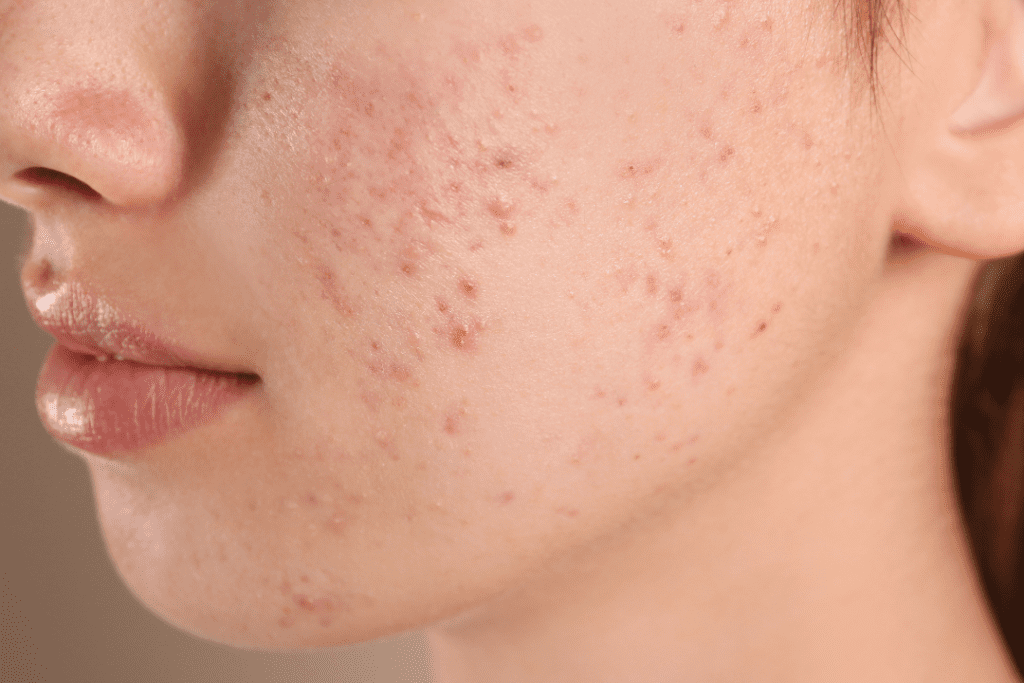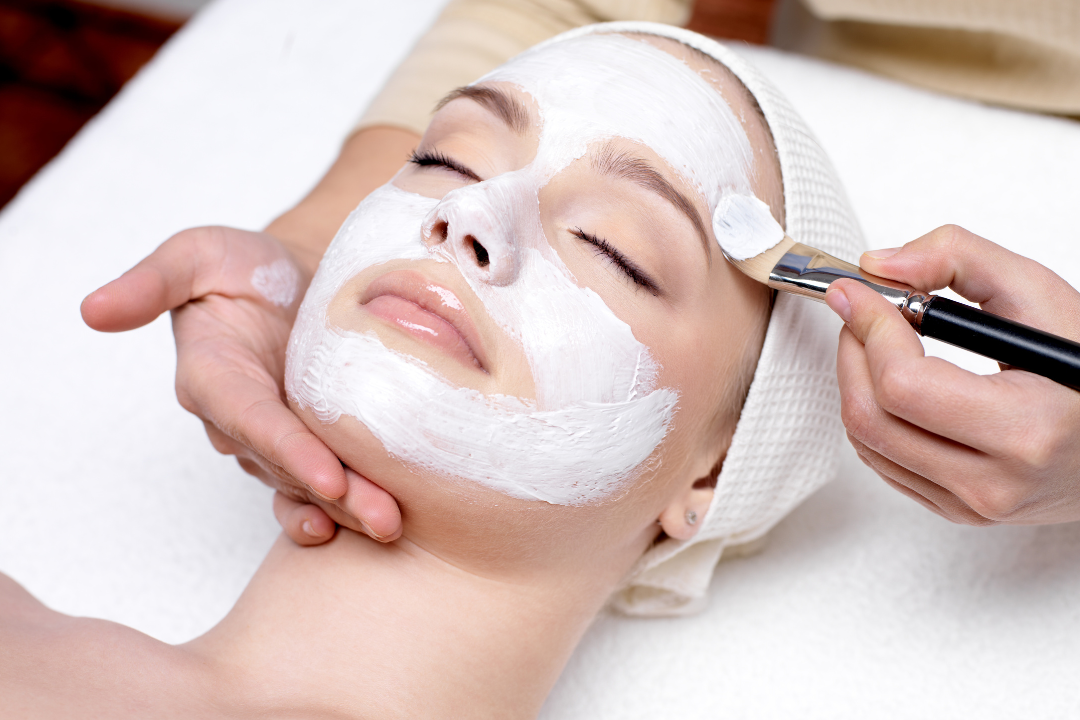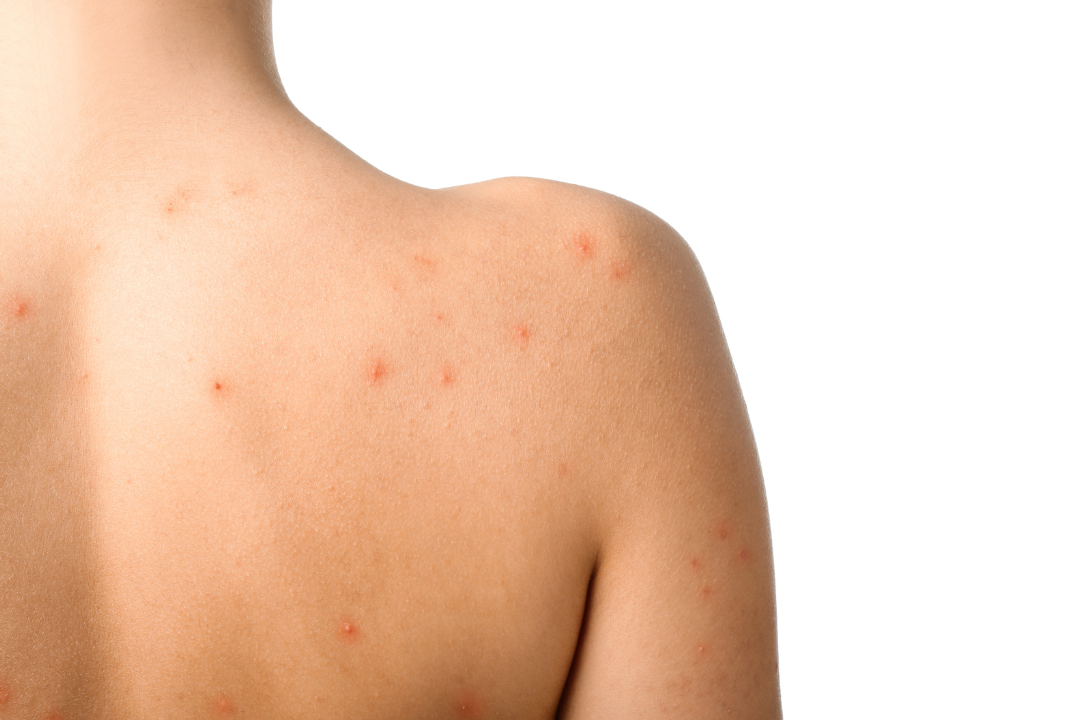Ever noticed how pimples always seem to show up in the same spots on your face? The ancient method of acne face mapping might explain why. It’s based on traditional Chinese and Ayurvedic medicine. It says the spots where acne appears can tell us about our overall health.
Even though modern science isn’t fully on board, skincare pros find it useful. By looking at where acne shows up, we can figure out what might be causing it. This could be anything from hormonal changes, environmental factors, or our daily habits. Our skin might be trying to tell us something important about our health.
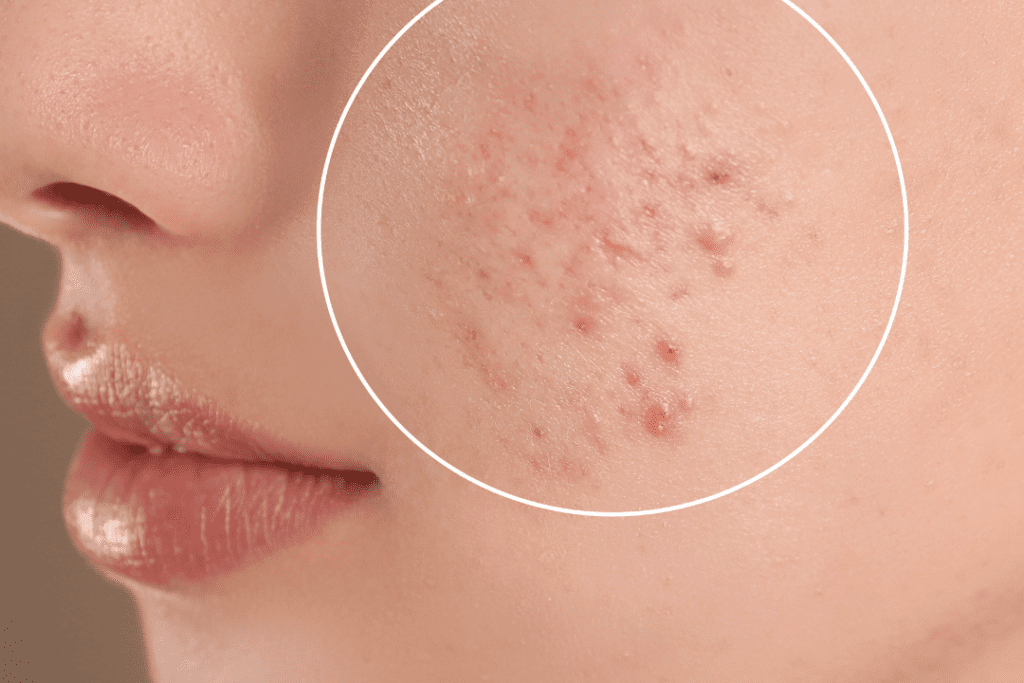
At OasisMD in Vancouver, we take a holistic view of skin health. We mix ancient knowledge with modern skincare to help you understand your skin better. By doing this, we can create a plan just for you to get clearer, healthier skin. Are you ready to learn more about your acne and what your skin is trying to tell you? Let’s explore acne face mapping together and discover what your skin is sharing.
Key Takeaways
- Acne face mapping links breakout locations to potential health issues
- Facial acne patterns can offer clues about underlying causes
- Common acne triggers include hormones, environment, and genetics
- Understanding breakout patterns aids in developing targeted skincare
- OasisMD in Vancouver offers personalized skin health solutions
Introduction to Acne Face Mapping
Face mapping is an old practice from traditional Chinese medicine and Ayurveda. It connects different parts of the face to internal organs and body systems. Even though it’s not scientifically proven, it gives clues about acne triggers.
Today, dermatologists use face mapping for skin analysis. They look for patterns to make personalized treatment plans. This mix of old wisdom and new skincare knowledge helps tackle acne well.
At OasisMD in Vancouver, we use face mapping in our skin analysis. It helps us find out why you might be getting breakouts and create targeted treatments. Our team at 8138 Granville Street combines ancient practices with modern dermatology for the best care.
“Face mapping is a powerful tool that bridges the gap between traditional healing practices and contemporary skincare.”
Knowing your facial map can reveal internal imbalances causing acne. This could be hormonal changes, what you eat, or your lifestyle. Face mapping can lead you to clearer, healthier skin.
Want to see how face mapping can improve your skin? Call OasisMD at 604 630 3833 or email info@oasismd.ca to set up a skin analysis session today.
The Science Behind Acne: Causes and Triggers
Acne vulgaris affects many Canadians. Knowing what causes it helps in managing breakouts. Let’s look at the science and main triggers of acne.
Hormonal Influences on Acne
Hormones are key in making sebum, which can block pores. In puberty, hormonal shifts lead to more oil, making teens more likely to get acne. Adults can also get breakouts due to hormonal changes during their periods or pregnancy.
Environmental Factors
Your environment affects your skin. Pollution, humidity, and extreme weather can cause inflammation and acne. People living in cities like Vancouver face more stressors that can harm their skin.
Genetic Predisposition
Your genes can affect your acne risk. If your parents had acne, you might too. Genetic factors influence how your skin reacts to hormones and the environment.
| Factor | Impact on Acne | Management Strategy |
|---|---|---|
| Hormones | Increased sebum production | Hormonal treatments, consistent skincare routine |
| Environment | Skin inflammation, clogged pores | Regular cleansing, protective skincare products |
| Genetics | Higher susceptibility to acne | Personalized treatment plans, early intervention |
At OasisMD in Vancouver, we know how complex acne is. Our experts can create a plan just for you. Call us at 604 630 3833 or visit us at 8138 Granville Street to find out how to manage your acne.
Decoding the Acne Face Map
Acne face mapping is a way to understand your skin better. It helps you see how different parts of your face react to things. By knowing this, you can make skincare routines that work just for you.
Each part of your face can be affected differently by acne triggers. Let’s look at how these areas might be connected to acne causes:
| Facial Zone | Common Causes | Skincare Focus |
|---|---|---|
| T-Zone | Excess oil production | Oil control, gentle exfoliation |
| Cheeks | Environmental factors, diet | Protection, detoxifying treatments |
| Chin and Jawline | Hormonal fluctuations | Balance-restoring products |
| Forehead | Hair products, stress | Clarifying treatments, stress reduction |
Knowing where you get acne helps you focus your skincare. Tailoring your routine to your needs can lead to better results. But remember, face mapping is not a precise science.
For a detailed skin check-up and advice on skincare that fits you, visit OasisMD at 8138 Granville Street, Vancouver BC. Call us at 604 630 3833 or email info@oasismd.ca to set up a meeting today.
Forehead and T-Zone Breakouts
The T-zone, which includes your forehead, nose, and chin, is known for oily skin and breakouts. Knowing what causes and how to treat these areas can lead to clearer skin.
Common Causes
Acne in the T-zone often comes from too much oil and clogged pores. Hormonal shifts, stress, and hair products can make it worse. This oily skin is likely to form comedones, which can lead to acne.
Treatment Options
Here are some ways to tackle T-zone breakouts:
- Salicylic acid: Unclogs pores and lowers oil production
- Benzoyl peroxide: Kills bacteria that cause acne
- Oil-free moisturizers: Moisturizes without adding oil
Prevention Strategies
To keep your T-zone clear:
- Cleanse your face twice a day with a gentle, oil-free wash
- Choose hair products that are oil-free and won’t clog pores
- Change your pillowcase often
- Reduce stress through exercise or meditation
| Skin Type | Recommended Treatment | Frequency |
|---|---|---|
| Oily | Salicylic acid cleanser | Twice daily |
| Combination | Benzoyl peroxide spot treatment | As needed |
| Sensitive | Gentle, non-comedogenic moisturizer | Daily |
For personalized advice on managing T-zone breakouts, visit OasisMD at 8138 Granville Street, Vancouver BC, or call 604 630 3833. Their expert team can create a tailored skincare plan to address your unique needs.
Cheek Acne: Unmasking the Culprits
Cheek breakouts can be frustrating and hard to get rid of. Knowing what causes them is the first step to clear skin. Let’s look at the main causes and how to fix them.
Bacteria are a big part of cheek acne. Your face meets many microbes every day, and some can harm your skin. A surprising source of bacteria is your cell phone. Not cleaning it well can spread germs to your cheeks when you talk on it.
Makeup brushes can also cause acne. If they’re not cleaned often, they can grow bacteria. It’s important to wash your makeup tools regularly to keep your skin clear.
| Cause | Prevention |
|---|---|
| Dirty cell phones | Clean your phone daily with alcohol wipes |
| Unwashed makeup brushes | Wash brushes weekly with gentle soap |
| Unchanged pillowcases | Change pillowcases twice a week |
| Touching your face | Be mindful and avoid touching your face |
Things around us can also cause cheek acne. Air pollution can clog pores and upset your skin. To fight this, wash your face well every night and use a purifying mask once a week.
If you have ongoing cheek breakouts, OasisMD in Vancouver can help. Call them at 604 630 3833 or visit their clinic at 8138 Granville Street for personalized care.
“Prevention is key when it comes to cheek acne. Simple changes in your daily routine can make a big difference in your skin’s health.”
By tackling these common causes and sticking to good skincare, you can lessen cheek acne. This way, you can have clearer, healthier-looking skin.
Chin and Jawline Acne: Hormonal Connections
Acne on your chin and jawline often means you have hormonal imbalances. This breakout is common during certain life stages and can be tough to handle.
The Role of Androgens
Androgens are key in hormonal acne. They make oil glands work too much, leading to too much sebum. This oil and dead skin cells can clog pores, causing breakouts on your chin and jawline.
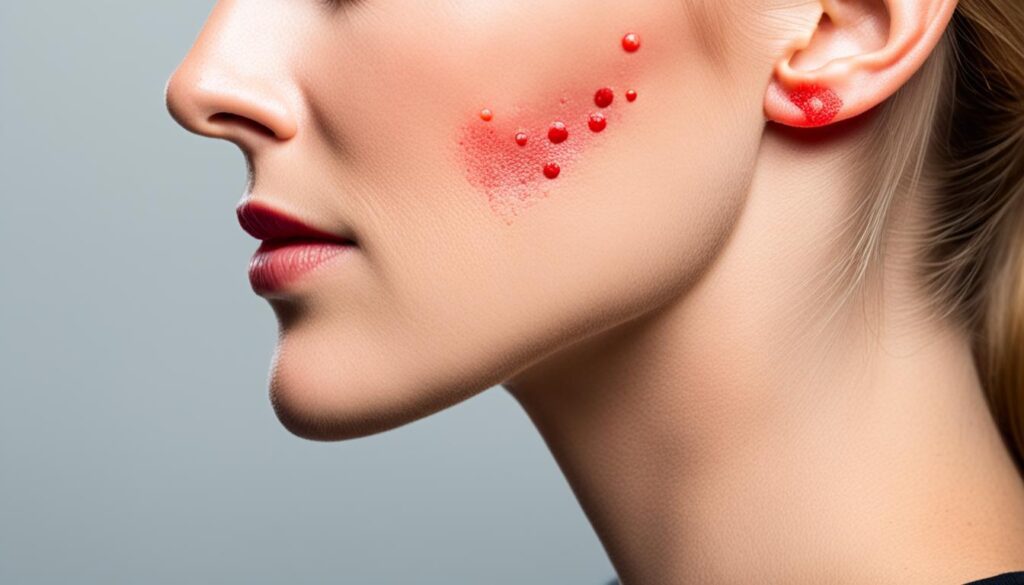
Menstrual Cycle and Acne
Your menstrual cycle can make acne worse. Many women get breakouts about a week before their period. This happens because of hormonal changes during the month.
Treating Hormonal Acne
To treat hormonal acne, you need a focused plan. Birth control pills can help balance hormones and lessen breakouts. Spironolactone, an anti-androgen drug, is also good for managing hormonal acne.
- Use topical retinoids to unclog pores
- Consider dietary changes, like reducing dairy intake
- Maintain a consistent skincare routine
If you’re dealing with persistent chin and jawline acne, reach out to OasisMD in Vancouver. Their experts can give you personalized treatment plans for clearer skin.
“Understanding the hormonal connection to acne is key to effective treatment.”
For expert advice on managing hormonal acne, call OasisMD at 604 630 3833 or visit them at 8138 Granville Street, Vancouver BC.
Nose and Upper Lip Blemishes
Your nose and upper lip are common places for blemishes. These areas have many sebaceous glands, which can cause blackheads and whiteheads. When oil and dead skin cells block your pores, these spots appear.
Blackheads happen when pores get clogged but stay open. The trapped debris darkens when it’s exposed to air. Whiteheads occur when pores close, trapping oil and bacteria inside.
To fight these blemishes, try these tips:
- Use a gentle cleanser with salicylic acid to unclog pores
- Apply a clay mask weekly to absorb excess oil
- Try pore strips for quick blackhead removal
- Exfoliate gently to remove dead skin cells
Be careful not to scrub your skin too hard, as it can irritate it and worsen acne. Stick to a gentle skincare routine. If you’re dealing with persistent blemishes, OasisMD at 8138 Granville Street, Vancouver BC, can help. Their experts offer personalized treatments. Call 604 630 3833 or email info@oasismd.ca to set up an appointment.
Neck and Hairline Acne: Often Overlooked Areas
Dealing with acne on your neck and hairline can be tough. These spots often get ignored but can really affect how you look and feel. Let’s look into why these breakouts happen and how to fix them.
Impact of Hair Products
Maybe your hair care routine is causing acne without you knowing. Pomade acne is a big problem along the hairline, thanks to oil-based hair products. These can clog pores and cause breakouts. To stop this, choose non-comedogenic hair products that won’t clog your pores.
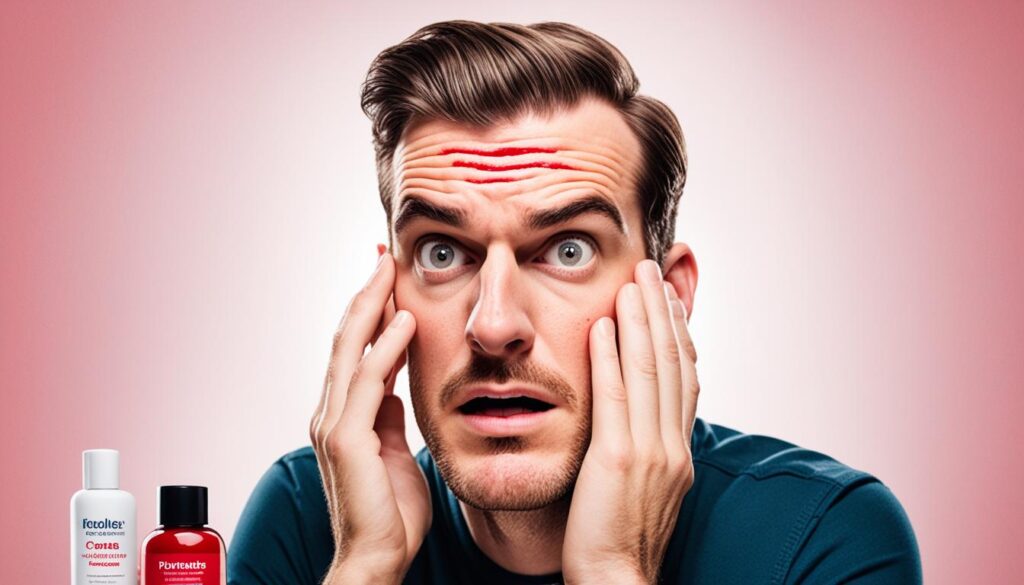
Addressing Neck Acne
Neck acne can come from sweat, tight clothes, and hair product residue. To fight this, wash your neck well when you wash your face. Also, wear loose clothes to prevent sweat and bacteria from getting trapped on your skin.
Preventing Hairline Breakouts
To keep your hairline clear, use a clarifying shampoo often. This removes product buildup that can cause acne. After styling, clean your hairline with a damp cloth to get rid of any extra residue.
By focusing on these often-missed spots and changing your hair care habits, you can cut down on neck and hairline acne. For tailored advice on treating tough acne, visit OasisMD at 8138 Granville Street, Vancouver BC, or call 604 630 3833.
Holistic Approaches to Acne Management
Using a holistic approach to manage acne can lead to great results. What you eat greatly affects your skin’s health. Foods with lots of sugar and dairy can cause breakouts. So, eating fewer of these and more fruits, veggies, and lean proteins is a good idea.
Managing stress is also vital for clear skin. Here are some ways to relax:
- Deep breathing exercises
- Yoga or meditation
- Regular physical activity
Good sleep is key to fighting acne. Try to get 7-9 hours of sleep each night. Make a bedtime routine and keep your bedroom cool and dark for better sleep.
Having a good skincare routine is crucial. Clean your face twice a day with a gentle cleanser. Then, use a toner and moisturizer right for your skin. Exfoliate once or twice a week to get rid of dead skin.
“Treating acne holistically involves addressing various lifestyle factors, not just applying topical treatments.”
For personalized advice on holistic acne management, call OasisMD at 604 630 3833 or visit them at 8138 Granville Street, Vancouver BC. Their experts can create a plan just for you.
Conclusion
Acne face mapping is a special way to understand what your skin needs. It helps you see where breakouts happen, so you can change your skincare for better results. This method makes skincare more personal, focusing on your specific skin issues.
Even with face mapping, getting expert advice is key. If you have tough or serious acne, seeing a dermatologist is a must. They can make a plan just for you, addressing your skin’s unique needs.
Preventing acne is about more than just creams and gels. It’s about eating well, managing stress, and taking good care of your skin. At OasisMD in Vancouver, we’re ready to help you get healthier skin. Call us at 604 630 3833 or come to 8138 Granville Street to begin your path to clearer skin.
FAQ
What is acne face mapping?
Acne face mapping is a method that links acne spots to possible health issues or triggers. It comes from ancient Chinese and Ayurvedic traditions, but it’s not backed by science.
How can acne face mapping be helpful?
It’s not a hard science, but acne face mapping can offer clues about acne causes. It suggests certain areas of the face might react to certain triggers.
What causes acne?
Acne happens when the skin’s oil glands and hair follicles get inflamed. Things like hormones, the environment, genes, and lifestyle can lead to acne.
What are the common causes of forehead and T-zone acne?
Forehead and T-zone acne often stem from too much oil and clogged pores. Hormonal shifts, stress, and certain hair products can cause this.
How can I treat cheek acne?
To fight cheek acne, keep your phone, makeup tools, and bedding clean. Use non-comedogenic makeup and skincare, exfoliate gently, and try spot treatments.
Why is chin and jawline acne common?
Chin and jawline acne is often linked to hormonal changes. It’s common during certain times like the menstrual cycle, pregnancy, and menopause.
What causes blackheads and whiteheads on the nose and upper lip?
The nose and upper lip are prone to blackheads and whiteheads because of many sebaceous glands. These happen when pores get clogged with sebum and dead skin.
How can I prevent neck and hairline acne?
To stop neck and hairline acne, use hair products without comedogenic ingredients. Clean the area after styling, wear loose clothes, and use clarifying shampoos to avoid buildup.
What lifestyle factors can contribute to acne?
Diet, stress, and sleep habits can affect acne. Managing stress, eating right, and following good skincare routines can help control acne.

